Moroccan living room design: the warmth of authenticity and the charm of global elegance
The Moroccan living room design plays a major role in our daily lives and receives great attention because it is where we spend a lot of time; therefore, whether you are one of the people interested in global decor and designs inspired by different cultures, one of the individuals looking for distinctive Moroccan designs for their homes, or one of the people who want to explore the beauty of Moroccan culture through interior design, or one of the interior designers who seek to apply Moroccan designs to their clients, or one of the people who want to integrate the Moroccan character into their homes.
This article is for you, especially in countries like the United States, Europe, and the Gulf. In this article, we will highlight the unique elements that make Moroccan design distinctive, and we will also provide you with practical ideas for designing a Moroccan living room design that combines authenticity and beauty.
Table of Contents
Main features of Moroccan living rooms
- Definition of Moroccan living rooms
The Moroccan living room design, or sitting room, is a room in the house for the purpose of relaxation and family gatherings. This room is sometimes called the front room when it is located near the main entrance at the front of the house. The term living room may sometimes be used synonymously with the living room, although the living room may also be found in a hotel or any other public place. The living room was coined in the late nineteenth or early twentieth century. In this topic, we will discuss Moroccan-style living rooms.
This 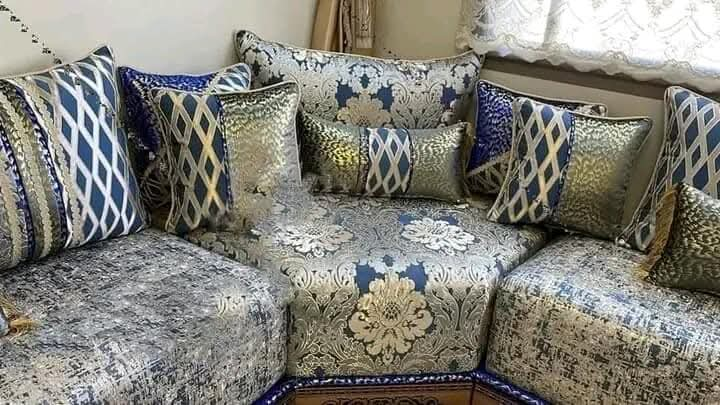 receives great attention from Moroccans because the mirror reflects the interior facade of the house. Today, we will show you wonderful living rooms in the elegant Moroccan style characterized by antiquity, elegance, and luxury. It also carries part of the history of high-end Islamic art with wonderful colours and patterns. Moroccan interior designs often combine elements of nature, vibrant colours, highly decorative furniture and accessories, plants, and soft lighting to achieve an ideal interior environment. Here are the features of Moroccan decor:
receives great attention from Moroccans because the mirror reflects the interior facade of the house. Today, we will show you wonderful living rooms in the elegant Moroccan style characterized by antiquity, elegance, and luxury. It also carries part of the history of high-end Islamic art with wonderful colours and patterns. Moroccan interior designs often combine elements of nature, vibrant colours, highly decorative furniture and accessories, plants, and soft lighting to achieve an ideal interior environment. Here are the features of Moroccan decor:
- 1 – Low and comfortable furniture
Sofas in Moroccan living room design are the main element of living rooms, usually covered with decorative fabrics such as velvet or cotton. These sofas are comfortable and low, providing an atmosphere of relaxation and warmth. Their spacious design allows for the accommodation of many people, reflecting the welcoming character and Moroccan hospitality.
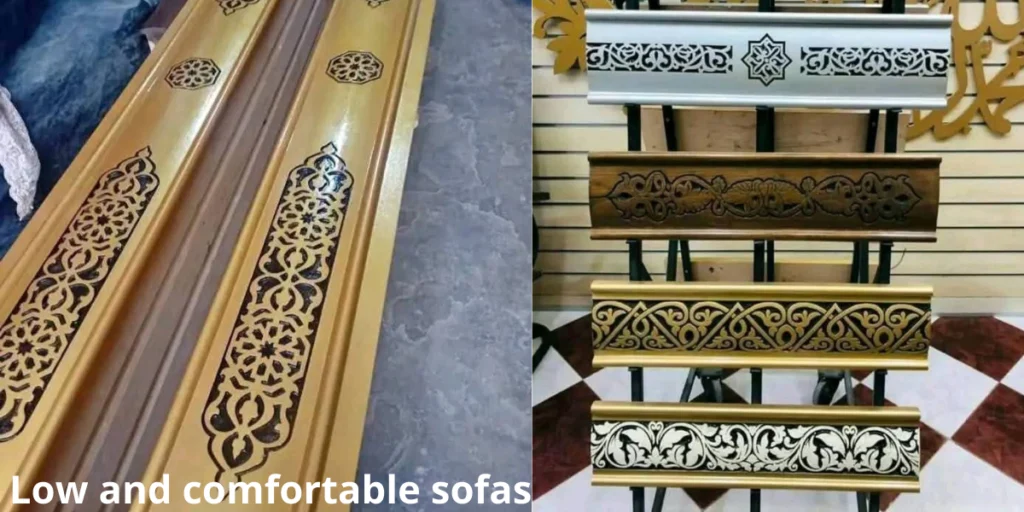
Textiles in Moroccan decor are a wonderful mix of fabrics that add layers and texture to the design. The chosen fabrics are often luxurious, bold, and rich in colours, such as gold, red, and blue, which enhance the beauty of the place. These fabrics are used in sofas, pillows, curtains, and even carpets, creating a visual harmony that distinguishes Moroccan decor.
The careful selection of these fabrics contributes to highlighting the traditional Moroccan identity while providing comfort and appeal to any living room inspired by Moroccan heritage
- 2 – bold and warm colours:
Moroccans do not hesitate to use bright, warm colours with their interior decorations. Different shades of blue, red, pink, and purple make it look warm and inviting. The walls, the fabric of the furniture, the linen, and everything else get their share of these vibrant colours; surprisingly, they never seem too much or exaggerated.
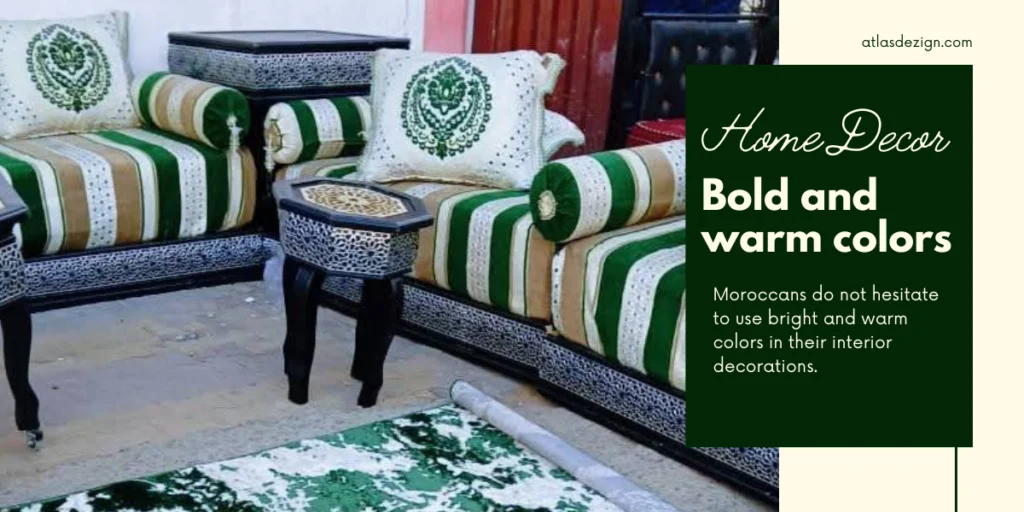
However, the truth is that almost any style can be created with neutral and basic colours. While it is true that Moroccan culture is full of colours and details, we can adapt it to our tastes if we prefer environments with shades such as white or grey. In this sense, we must add details such as Berber carpets in shades of white with black diamonds, a grey metal table, or a mirror with arabesque in the frame in colour such as white or silver. Arabic-style lamps can also be found in metal without further shades, so it is possible to have such a decoration in neutral colours.
In addition to the vibrant colours, Moroccan interiors are characterized by fine details—from the ceiling to the floors. Whether it’s stairs, cabinets, doors, or floors, one can see intricate details and eye-catching patterns throughout Moroccan homes. Moroccan living room design also incorporates bold colours, such as fuchsia, royal blue, deep purple, and vibrant red, with the muted neutral colours of the desert, such as sand, dark grey, beige, and shades of white. Bold walls are common in this design style. These colours add a lively and warm feel to the room and create an atmosphere of comfort and hospitality.
- 3 Traditional Patterns and Ornaments
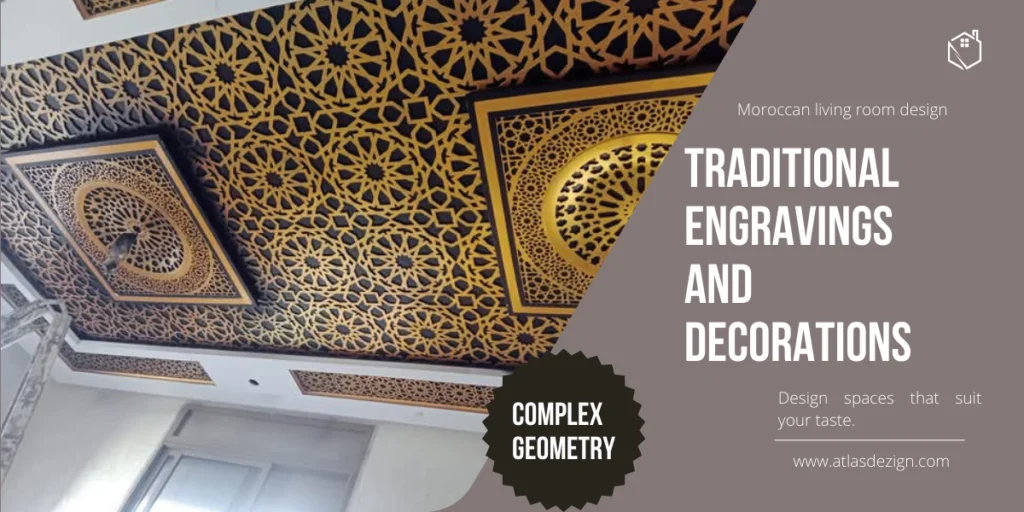
Moroccan living room designs are adorned with exquisite decorative patterns on the furniture. Moroccan-style furniture typically features intricate geometric patterns, vibrant colours, and bold textures. Patterns are often inspired by traditional Islamic art and architecture and local motifs. Furniture pieces often feature intricately carved wood accents or hand-painted details. Common materials used in Moroccan-style furniture include wood, leather, metal, stone, and tile. Rugs and carpets are also common elements of Moroccan furniture, which can be decorated with patterns or bright colours to add a touch of exotic flair to any room.
Walls in Moroccan design
Walls are considered one of the important elements in Moroccan living room design, as they reflect a combination of luxury and authenticity through special materials and techniques that give the place a unique beauty.
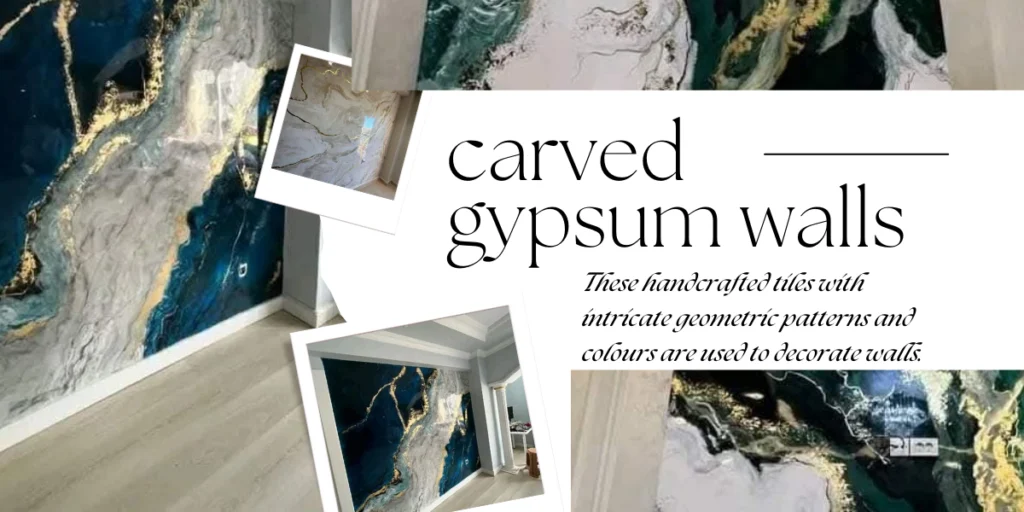
- 1 Moroccan Zellige (decorative tiles):
Moroccan zellige walls are one of the most distinctive features. These handcrafted tiles with intricate geometric patterns and colours decorate walls completely or as decorative accents. Zellige can be seen on the lower parts of walls or columns, giving the room a traditional feel.
- 2 Carved gypsum walls:
Geometric motifs and Moroccan-style ceilings often feature intricate geometric patterns and vibrant colours. They are usually made of plaster and wood and are painted in various colours, including blue, green, yellow, and red. The ceilings are then decorated with decorative pieces such as tiles, mosaics, carved wood, or stone. These pieces often display geometric or floral designs that add a unique beauty to the ceiling.
In addition to these decorative elements, Moroccan ceilings may also feature intricate plasterwork, beaded curtains, and pendant lights. These details add an exotic charm to the overall design of the room. Hanging chandeliers are an integral part of any Moroccan ceiling design. Expensive Moroccan interiors feature hand-painted ceilings that mimic a carpet pattern framed by curved or hand-painted edges. It takes a lot of skill and time to create a ceiling of this type, but the result is worth the time and effort
- 3 – Decorative wood:
In some designs, parts of the walls are covered with hand-carved wooden panels that add warmth and a unique traditional character. Moroccan walls are not just boundaries of space; they are artistic panels that highlight the beauty of Moroccan culture and add luxurious visual dimensions to any living room inspired by this ancient heritage.
- 4 Dim lighting and lanterns:
Moroccan lamps and lanterns are among the most prominent elements that add beauty and authentic spirit to interior design. These lamps can be floor-standing, suspended from the ceiling, or distributed on tables.
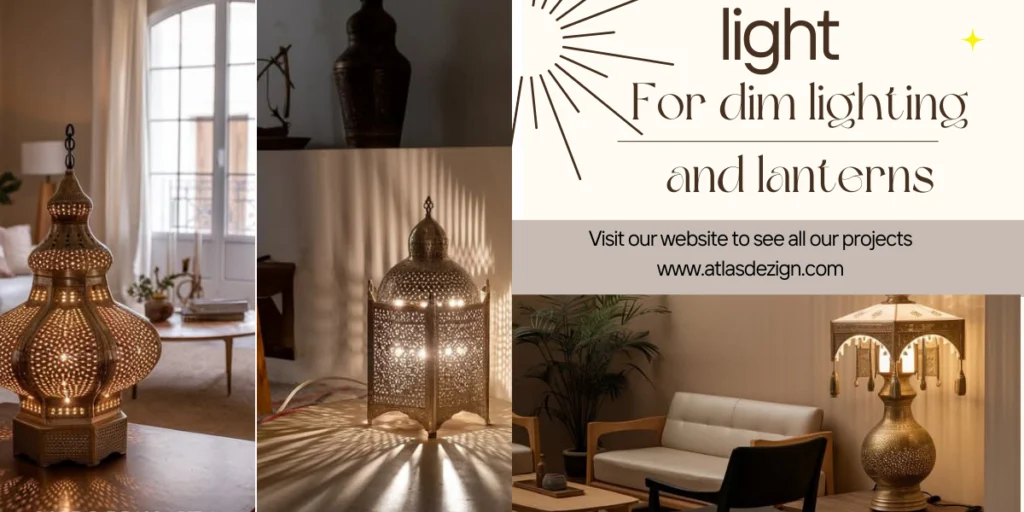
Lamps are usually made of metal and decorated with coloured crystals, with options in single colours. Moroccan lanterns of copper highlight traditional patterns and geometric designs, creating a warm atmosphere that enhances the Moroccan spirit in the place. Copper can also be combined with coloured glass to add touches of colour when lighting.
Some lanterns come in gold or silver colours, giving them a luxurious look that suits modern decorations.
How to integrate lanterns into the decor:
- Hang large lanterns in the room to create a focal point.
2. Distribute small lanterns on tables or shelves to decorate the space.
3. Place lanterns in corners with rugs and pillows to enhance the authentic Moroccan character
How to Bring Moroccan Style into Your Home
- 1 Use of natural materials:
Moroccan living room design relies heavily on natural materials to add an authentic and warm touch to spaces. These materials reflect the Moroccan culture’s connection to nature and traditional craftsmanship, balancing simplicity and luxury.
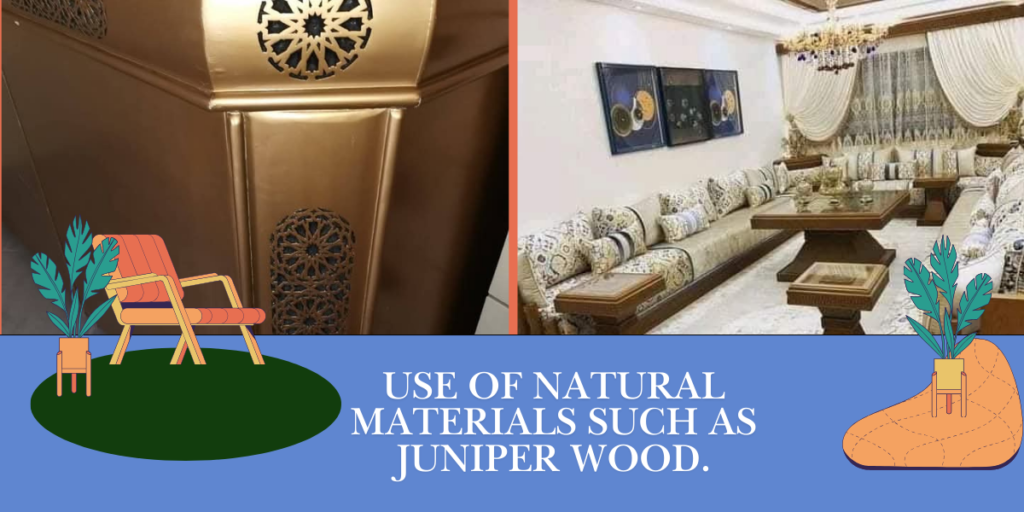
- Wood:
- Wood is one of the main elements in the design of Moroccan living rooms. Carpentry in Morocco has a special status, especially the use of juniper wood, which is distinguished by its beauty and health benefits. It is used in furniture manufacture and is distinguished by its antibacterial and antifungal properties, making it useful in preventing some diseases, such as bacterial and fungal infections, effectively preventing skin infections and wounds.
- Copper:
- Copper is a common metal in Moroccan interior design used to make various decorative items. Copper is characterized by its flexibility and ease of shaping, which adds a touch of luxury and authenticity.
- Wrought Iron:
- Wrought iron is traditionally used to manufacture Moroccan lamps, with gold and copper inlays to decorate the wooden panels and intricate furniture, highlighting the fine Moroccan craftsmanship.
- 2 Moroccan carpets:
One of the things we often see in Moroccan-style living rooms is rugs. There are many rugs inspired by Moroccan culture. Moroccan rugs are usually made of wool woven with intricate patterns and designs. These rugs often feature bold colours like red, blue, green, yellow, and orange. In fact, if you travel to Morocco and visit places like Marrakech, you can find shops that sell them and bring you an original souvenir for your home. Most of these rugs are inspired by their culture’s patterns and use geometric patterns with elaborate shapes and colours.
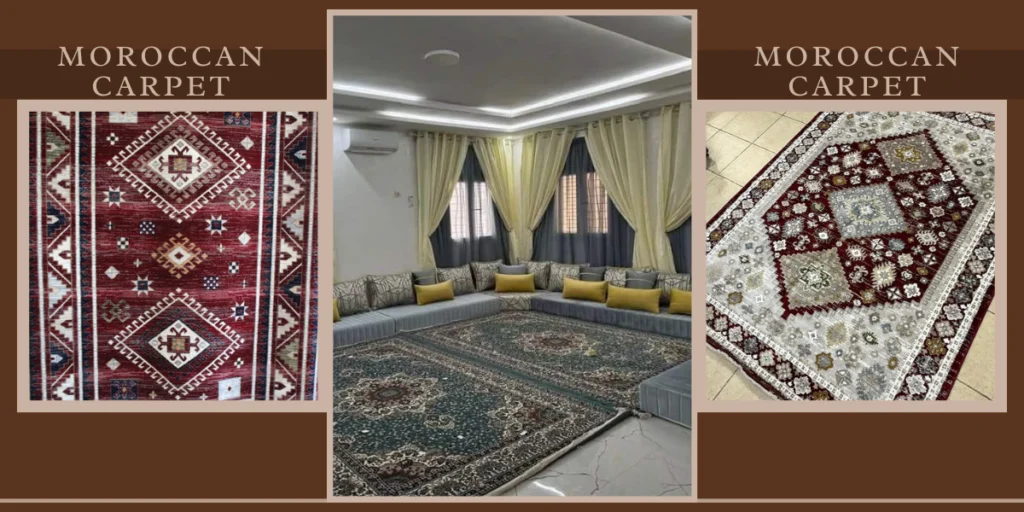
We can place rugs in the centre of the Moroccan living room design or dining room area. These rugs can range in size from small rugs to larger wall hangings. Still, traditional Moroccan rug designs have evolved to keep up with modern contemporary styles, as they are now made with patterns and colours that suit contemporary interior designs. Among these trends, black and white rugs are characterized by simplicity and elegance. This rug style has become popular worldwide, appearing in many homes and exhibitions. These rugs perfectly blend traditional Moroccan craftsmanship with modern décor needs.
- 3 Decorative pillows and bedspreads
Leather and decorative pillows are essential elements in the Moroccan living room design. They are characterized by their practicality and aesthetic appeal, making them one of the most popular souvenirs people bring back from traditional Moroccan markets, especially in Marrakech. They are also great for those looking to add a unique touch to their home. Traditional leather pillows are made of natural leather and are usually stuffed to be comfortable and durable.
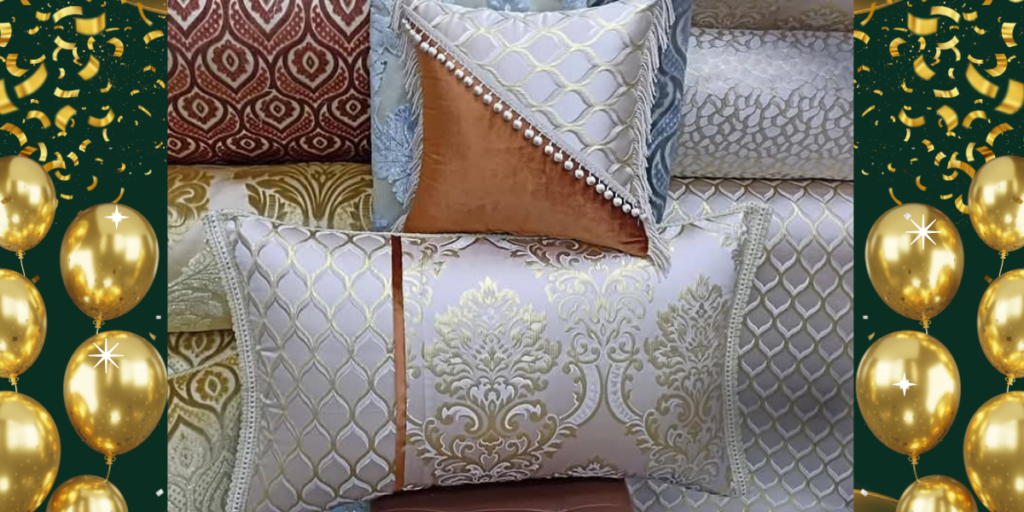
They are available in many colours to suit all tastes, but brown is the most common, adding warmth and elegance to the room. They are also used as sitting cushions to support the feet or as a decorative element highlighting the Moroccan character. Large pillows and decorative bedspreads are an important part of the decor of Moroccan living rooms. These pillows add comfort to sitting and give the room a lively and luxurious appearance.
- 4 low tables:
Among the details we can add to our Moroccan living room are the tea tables, an essential element that distinguishes Moroccan living rooms. They combine practical beauty with cultural traditions, making them an ideal addition to designing a living room that reflects Moroccan charm. The legs of the metal tables are distinguished by their elegance and are often made of copper or wrought iron, highlighting Moroccan craftsmanship.
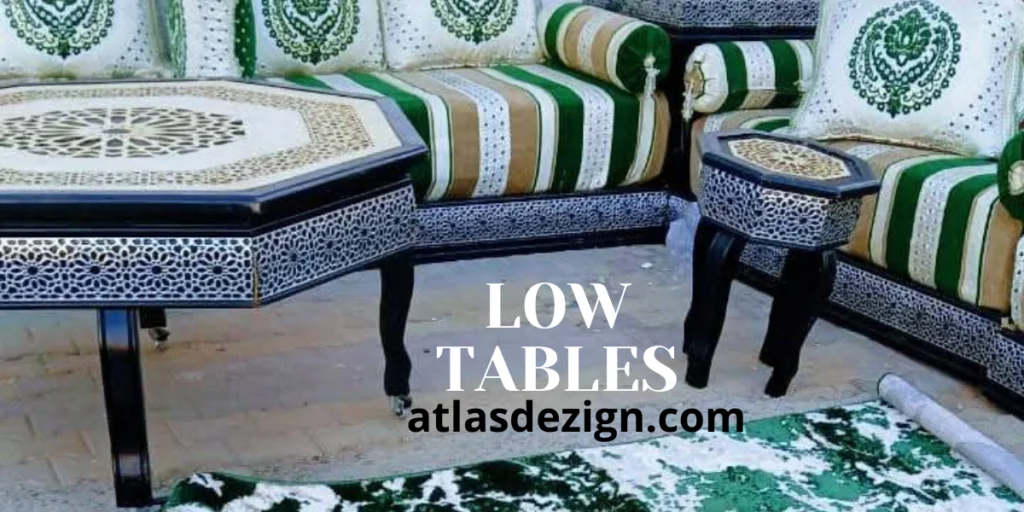
These tables have a surface that resembles a tray made of copper or silver and are often decorated with arabesque engravings that show the precision and uniqueness of the design. One of those details immediately reminds us of the Moroccan world, so it can be another piece of furniture you buy for your living room. The typical table on which some tea cups can be placed when visitors come to give everything a Moroccan touch.
The perfect blend of tradition and modernity.
- 1 Privacy and comfort:
Moroccan living room design focuses heavily on providing privacy and comfort, which makes them distinctive and ideal for meeting family and friends in a warm and comfortable atmosphere. Among the elements that contribute to achieving this, heavy curtains and velvet fabrics are an essential part of the design. Heavy curtains ensure that the living room is separated from other spaces or block the view from the outside, enhancing privacy. Curtains help control incoming light, creating a calm and comfortable atmosphere, especially during the day. Curtains are made of rich fabrics such as satin or heavy cotton and often contain traditional decorations and patterns that add an authentic Moroccan character.
- 2 Take advantage of open spaces
In Moroccan living room design, space utilization is essential to achieving harmony between beauty and comfort. Thanks to carefully distributing furniture and smart design elements, Moroccan living room design has become spacious and comfortable, even in small spaces. This gives the room a sense of spaciousness. The walls can be decorated with paintings or Moroccan mirrors that reflect light and brighten the place. These characteristics combine to create an environment of authenticity, beauty, and comfort that characterizes Moroccan living room design, making them ideal for family gatherings and welcoming guests.
In conclusion, Moroccan living rooms combine traditional beauty with modern comfort, making them an ideal place to relax or receive guests. An environment full of authenticity, beauty, and comfort can be created by using space intelligently and decorating the walls with elements such as paintings and Moroccan mirrors.
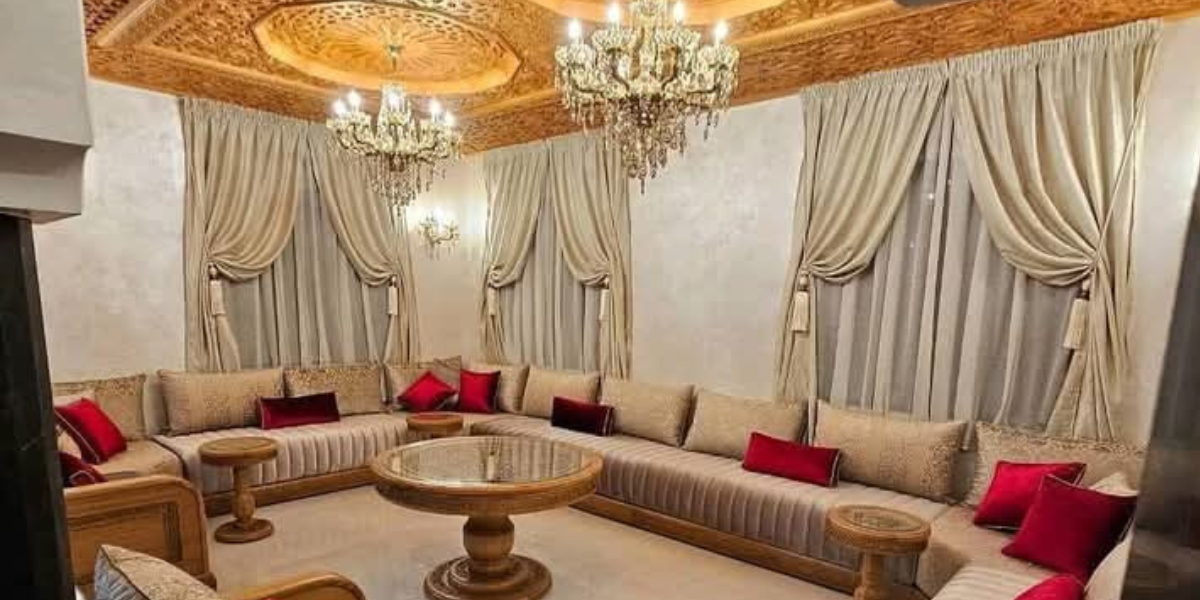
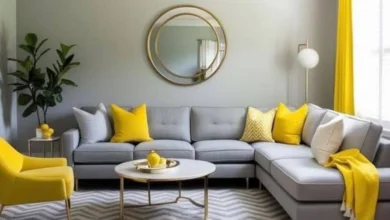 Living Room Decor Ideas: Wall Accents, Chic Pillows, and Charming Lighting
Living Room Decor Ideas: Wall Accents, Chic Pillows, and Charming Lighting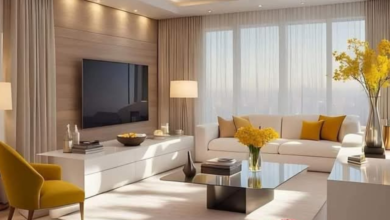 Common Living Room Design Mistakes to Avoid for a Stylish and Functional Look
Common Living Room Design Mistakes to Avoid for a Stylish and Functional Look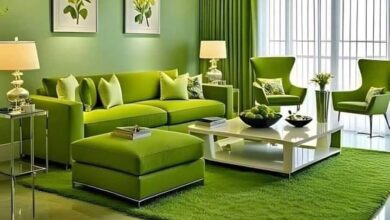 5-Creative Ideas to Decorate Your Living Room with Your Personal Touch and Unique Style
5-Creative Ideas to Decorate Your Living Room with Your Personal Touch and Unique Style